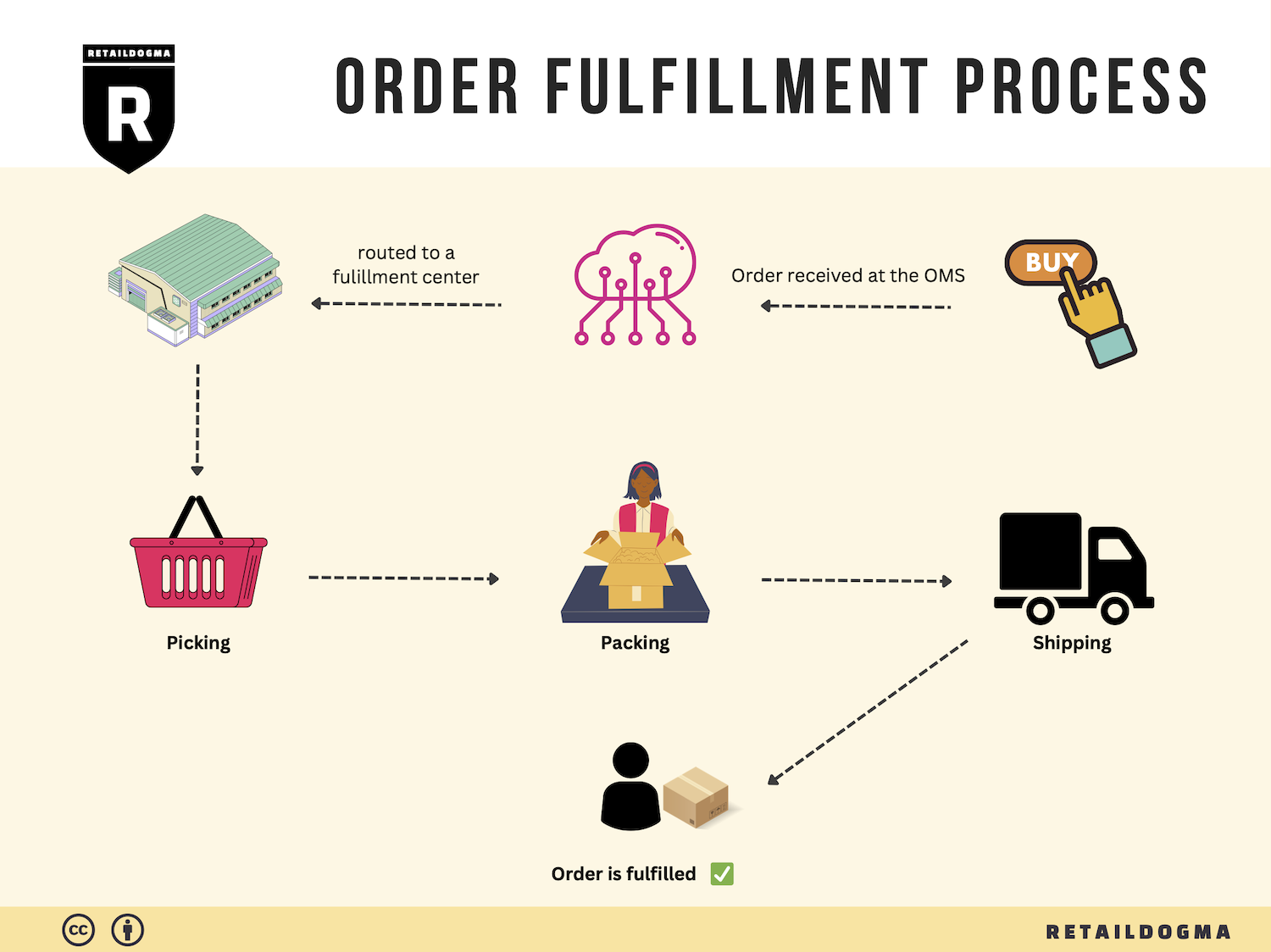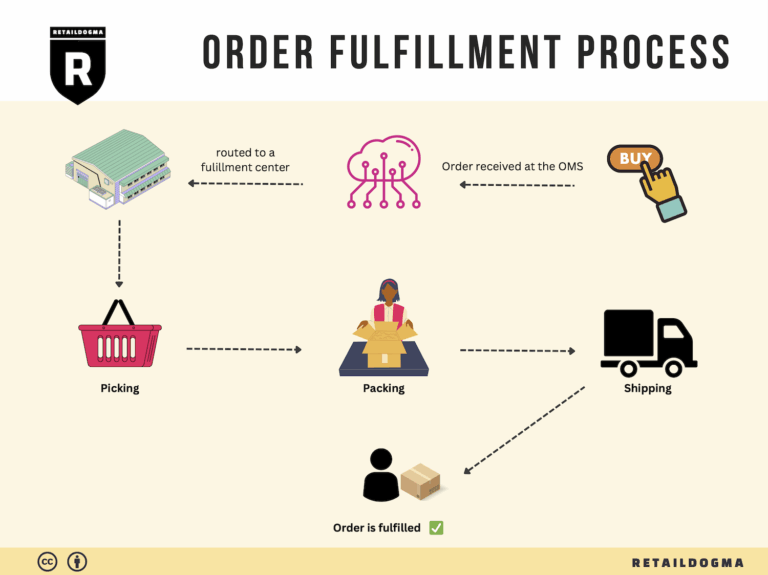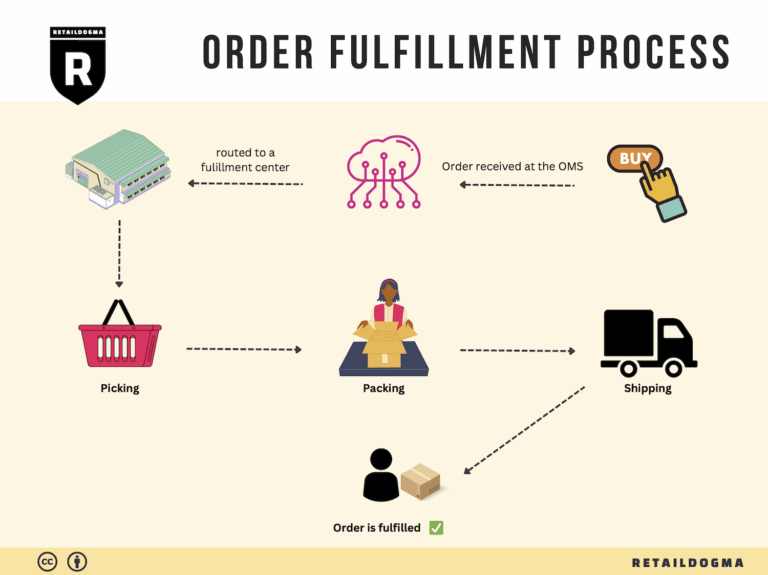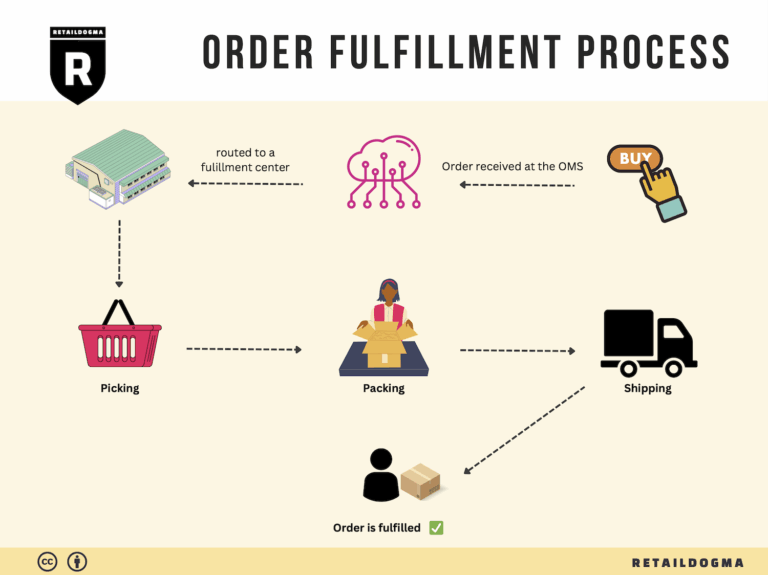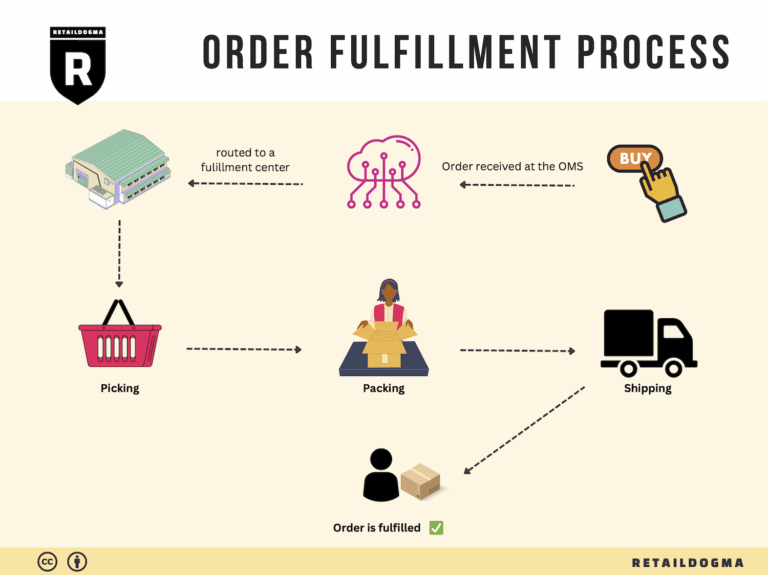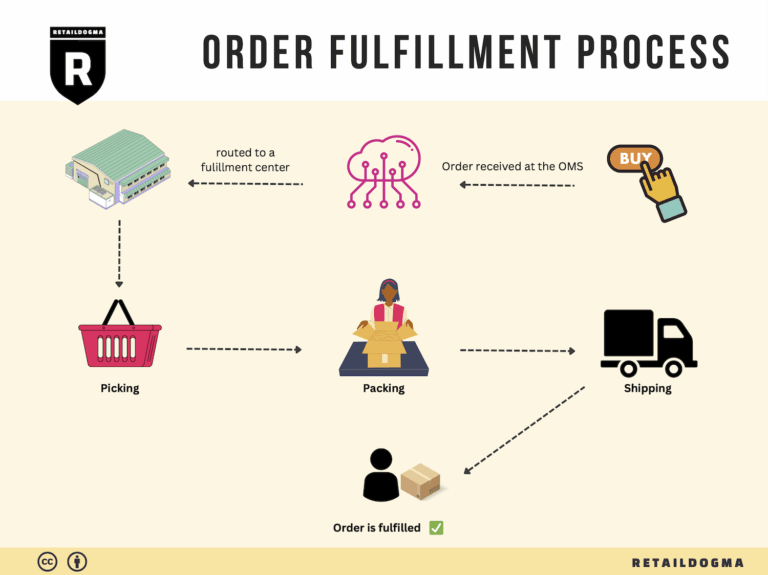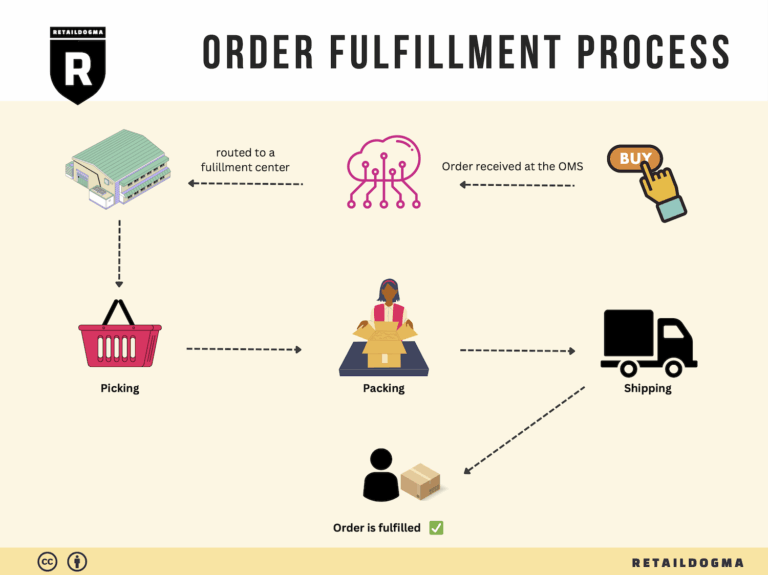What Is A Fulfillment Center? A Complete Guide (2025)
What is E-commerce Fulfillment? An Introduction for Growing Businesses
Understanding E-commerce Fulfillment
As an e-commerce business owner, you may often find yourself overwhelmed by the complexities of packing and shipping orders. This common pain point can stifle growth and divert your focus from scaling your sales. E-commerce fulfillment is the process of getting a product from your inventory into the hands of your customers, and it encompasses everything from order processing to shipping logistics.
The journey of fulfillment begins when a customer places an order. The product must be picked from your inventory, packed securely, and shipped to ensure it arrives on time and in good condition. For growing businesses, managing this process can be daunting, especially as order volumes increase. A robust fulfillment strategy is essential not just for operational efficiency but also for enhancing customer satisfaction and loyalty.
In this guide, we will explore various fulfillment models that can help streamline your operations. You’ll learn about Third-Party Logistics (3PL) providers, which handle storage, packing, and shipping on your behalf, and Fulfillment by Amazon (FBA), a popular choice that allows you to leverage Amazon’s extensive logistics network. Each model has its own advantages and considerations, and understanding these will help you choose the right fit for your business.
We will also dive into the core services involved in fulfillment. These include inventory management, order processing, packing, shipping, and returns handling. Each component plays a critical role in ensuring that your customers receive their orders promptly and accurately.
Choosing the right fulfillment partner can make or break your e-commerce success. This guide will provide you with insights on what to look for in a partner, including their technology capabilities, service offerings, and scalability to match your growth trajectory.
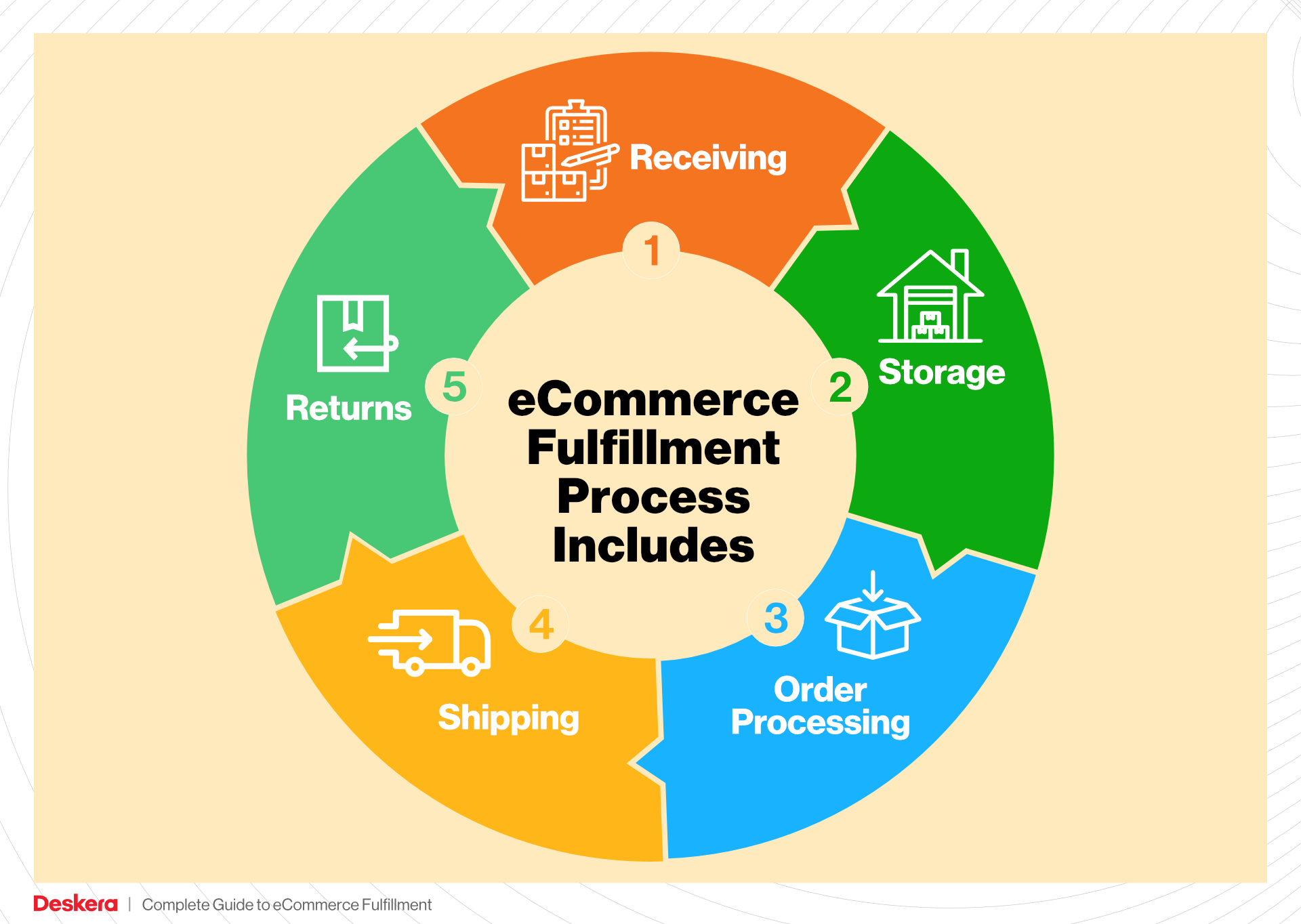
Finally, we will discuss pricing strategies and how to evaluate the cost-effectiveness of different fulfillment options. Transparent pricing is crucial for budgeting and ensuring that your fulfillment strategy aligns with your overall financial goals.
Our goal is to empower you to make informed decisions about your logistics. By understanding the intricacies of e-commerce fulfillment, you can develop a strategy that not only meets your customers’ expectations but also supports your business’s growth ambitions.
What You’ll Learn In This Guide
- What is E-commerce Fulfillment? An Introduction for Growing Businesses
- The Order Fulfillment Process: From ‘Buy’ Button to Customer’s Door
- Comparing Fulfillment Models: In-House vs. 3PL vs. Dropshipping
- A Deep Dive into Amazon FBA: Pros, Cons, and Who It’s For
- Core Services Offered by Fulfillment Centers
- How to Choose a Fulfillment Partner: A 6-Point Checklist
- Understanding Fulfillment Pricing: A Breakdown of Common Fees
- Frequently Asked Questions (FAQs) about Fulfillment
- Conclusion: Is Outsourcing Fulfillment the Right Move for Your Business?
- Important Disclaimer
The Order Fulfillment Process: From ‘Buy’ Button to Customer’s Door
1. Receiving Inventory
The first step in the order fulfillment process is the receiving of inventory. This involves the acceptance of goods from suppliers into the warehouse. Upon arrival, each item is checked against purchase orders to ensure accuracy in quantity and quality. This step is crucial as it establishes the foundation for inventory accuracy, which directly impacts stock availability and order fulfillment efficiency.
Key Term: SKU (Stock Keeping Unit) – Each product is assigned a unique SKU, which helps in tracking and managing inventory levels accurately. A well-organized receiving process ensures that the correct SKUs are logged into the inventory system, minimizing errors that could lead to stockouts or overstock situations.
2. Warehouse Storage
After the inventory is received, it is then stored in designated areas within the warehouse. Effective warehouse storage involves utilizing space efficiently while ensuring easy access to products. Items are categorized based on their SKU, demand frequency, and size, often utilizing systems such as FIFO (First In, First Out) for perishables.
This step is important because it influences the speed and efficiency of order picking later on. A well-structured storage system reduces the time spent locating items, which is essential for maintaining a smooth flow in the fulfillment process.
Key Term: ABC Analysis – This inventory categorization technique segments products into three categories (A, B, and C) based on their sales volume. This helps prioritize storage space and management efforts, ensuring that high-demand items (A) are easily accessible.
3. Order Picking
Order picking is the process of retrieving items from storage to fulfill customer orders. Once an order is placed, a pick list is generated, detailing the items and their locations in the warehouse. This step can be performed using various methods, including single order picking, batch picking, or zone picking, depending on the volume of orders and warehouse layout.
The significance of efficient order picking cannot be overstated; it directly affects order accuracy and customer satisfaction. Delays or errors in this step can lead to incorrect shipments, resulting in returns and increased operational costs.
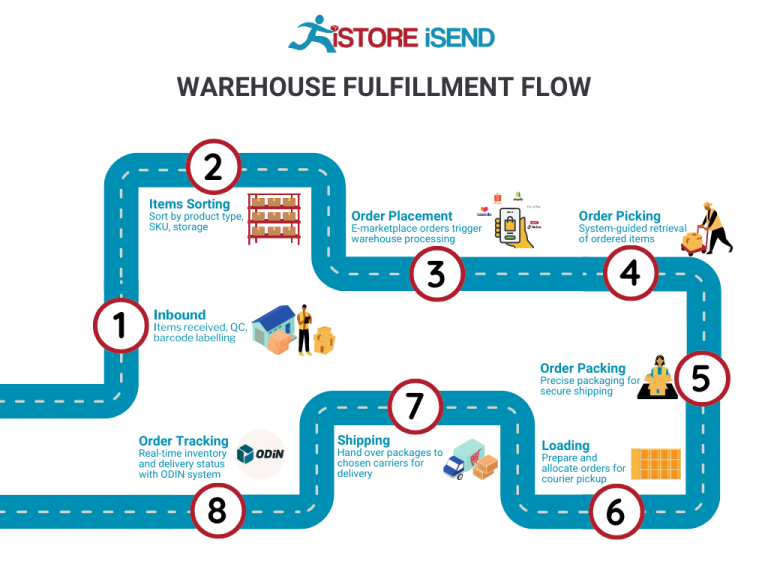
Key Term: Pick Lists – These are documents or digital displays that guide warehouse staff on what to pick for each order. They include essential information such as item SKUs, quantities, and locations, helping streamline the picking process.
4. Order Packing
Once items are picked, they are moved to the packing station, where they are prepared for shipment. This involves verifying the items against the order, selecting appropriate packaging materials, and ensuring that products are securely packed to prevent damage during transit.
The packing step is vital as it not only protects the products but also represents the brand to the customer. A well-packed order enhances customer experience, while poor packing can lead to product damage and dissatisfaction.
Key Term: Packing Slips – These documents accompany the shipment and include details about the items packed, providing transparency and helping customers verify their orders upon receipt.
5. Shipping & Delivery
The final step in the fulfillment process is shipping and delivery. Once packed, orders are labeled and handed over to shipping carriers for delivery. This phase involves selecting the most efficient shipping method based on factors like cost, delivery speed, and customer preferences.
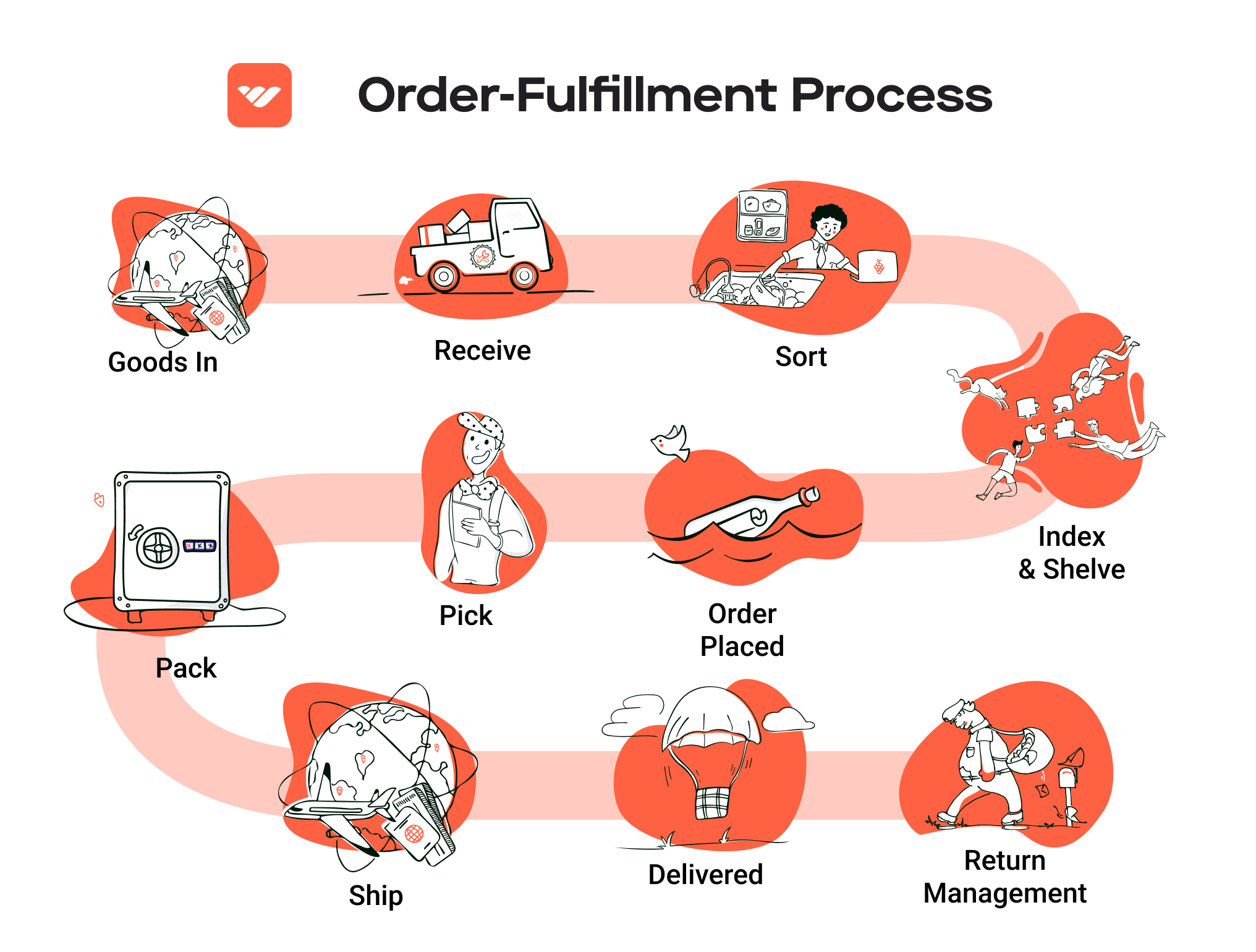
The importance of this step lies in its direct impact on customer satisfaction. Timely and accurate deliveries are crucial for retaining customers in the competitive e-commerce landscape. Businesses must continually assess and optimize their shipping strategies to improve delivery times and reduce costs.
Key Term: Last Mile Delivery – This term refers to the final leg of the delivery journey, from the distribution center to the customer’s door. It is often the most complex and costly part of the shipping process, and optimizing it can significantly enhance overall fulfillment efficiency.
By mastering these five steps of the order fulfillment process, e-commerce businesses can ensure a streamlined operation that enhances customer satisfaction and drives growth. Each phase, from receiving inventory to final delivery, plays a critical role in creating a seamless experience for customers and maintaining operational efficiency.
Comparing Fulfillment Models: In-House vs. 3PL vs. Dropshipping
Fulfillment Model Comparison
| Model | Who Handles Inventory | Best For (Business Stage) | Key Advantage | Key Disadvantage |
|---|---|---|---|---|
| In-House Fulfillment | The business itself | Established businesses | Full control over inventory and processes | High operational costs and resource-intensive |
| Third-Party Logistics (3PL) | A third-party provider | Growing businesses | Scalability and reduced overhead costs | Less control over inventory and fulfillment speed |
| Dropshipping | Suppliers/Manufacturers | Startups and small businesses | Low upfront investment and minimal risk | Lower profit margins and reliance on suppliers |
In-House Fulfillment
In-house fulfillment refers to a model where the business manages its own inventory and logistics operations. This includes warehousing, packing, and shipping products directly to customers. Established businesses often prefer this model because it allows for complete control over inventory management, fulfillment processes, and customer service. Businesses can tailor their logistics operations to meet specific customer needs, which can enhance customer satisfaction and loyalty. However, the primary disadvantage of in-house fulfillment is the high operational costs associated with maintaining a warehouse, hiring staff, and managing logistics. This model requires significant investment in infrastructure and technology, which can be a barrier for smaller or growing businesses. Additionally, as order volumes fluctuate, in-house fulfillment can lead to inefficiencies and increased labor costs.
Third-Party Logistics (3PL)
Third-party logistics (3PL) involves outsourcing fulfillment operations to specialized providers. This model is ideal for growing businesses that need to scale quickly without the burden of managing logistics themselves. A 3PL partner handles inventory storage, order processing, shipping, and returns, allowing businesses to focus on core activities like marketing and product development. The key advantage of using a 3PL is scalability; businesses can easily adjust their logistics capacity based on demand fluctuations. Moreover, 3PLs often have established relationships with carriers, which can lead to reduced shipping costs and improved delivery times. However, the downside is that businesses have less control over inventory management and fulfillment processes, which can lead to inconsistencies in customer service. Additionally, some businesses may find it challenging to align their brand values with those of their 3PL partner.
Dropshipping
Dropshipping is a fulfillment model where retailers do not keep products in stock. Instead, when a retailer sells a product, they purchase the item from a third party (typically a wholesaler or manufacturer) who then ships it directly to the customer. This model is particularly advantageous for startups and small businesses due to its low upfront investment and minimal risk. Retailers can offer a wide range of products without the need to invest heavily in inventory, making it easier to test new products or enter new markets. However, dropshipping also comes with significant challenges. Profit margins are typically lower compared to in-house fulfillment or 3PL due to the additional fees charged by suppliers. Retailers also face risks related to inventory availability and shipping times, as they are reliant on third-party suppliers. Furthermore, customer service can be complicated, as any issues with product quality or delivery times are often beyond the retailer’s control, potentially impacting brand reputation.
Conclusion
Each fulfillment model—In-house fulfillment, 3PL, and dropshipping—offers distinct advantages and disadvantages that can significantly impact a business’s operational efficiency and customer satisfaction. The choice of model should align with the company’s stage of growth, operational capabilities, and strategic goals. Businesses looking to scale should carefully evaluate their fulfillment needs and consider their long-term vision when deciding on the most suitable fulfillment strategy.
A Deep Dive into Amazon FBA: Pros, Cons, and Who It’s For
Understanding Fulfillment by Amazon (FBA)
Fulfillment by Amazon (FBA) is a service provided by Amazon that allows sellers to store their products in Amazon’s fulfillment centers. When a customer makes a purchase, Amazon takes care of storage, packaging, shipping, and customer service on behalf of the seller. This service enables sellers to leverage Amazon’s vast logistics network, making it easier to reach customers and streamline operations.
How FBA Works
-
Product Preparation: Sellers prepare their products according to Amazon’s guidelines, including labeling and packaging.
-
Shipping to Amazon: Once prepared, sellers ship their products to designated Amazon fulfillment centers. Sellers can create shipments through their Amazon Seller Central account.
-
Storage: Products are stored in Amazon’s fulfillment centers until they are sold. Amazon manages inventory levels and ensures that products are available for purchase.
-
Order Fulfillment: When a customer places an order, Amazon picks, packs, and ships the product directly to the customer. The seller benefits from Amazon’s fast shipping options, including Prime eligibility.
-
Customer Service and Returns: Amazon handles customer inquiries and returns, providing a seamless experience for customers and reducing the seller’s workload.
-
Payment Processing: Amazon processes payments and transfers funds to the seller’s account after deducting fees.
Pros of Using FBA
Prime Eligibility
One of the most significant advantages of FBA is that products become eligible for Amazon Prime. This status can significantly boost sales, as Prime members are more likely to purchase items that offer free two-day shipping. This not only increases visibility but also enhances customer trust.
Customer Trust
Amazon is a well-established brand known for its customer service and reliability. By using FBA, sellers can leverage this trust, as products fulfilled by Amazon are often perceived as more reliable. Customers are more likely to purchase from sellers that use FBA due to the assurance of Amazon’s return policies and customer support.
Multi-Channel Fulfillment
FBA allows sellers to fulfill orders from various sales channels, not just Amazon. This means that sellers can integrate their FBA account with other platforms, such as eBay, Shopify, or their own websites. This flexibility enables businesses to streamline their fulfillment processes across multiple marketplaces.
Scalability
Using FBA allows sellers to scale their businesses quickly without the need for significant investment in warehousing and logistics. As sales increase, sellers can send more inventory to Amazon without worrying about the logistics of fulfillment.
Advanced Logistics
Amazon’s advanced logistics and fulfillment infrastructure means that sellers benefit from efficient shipping and handling. The company utilizes sophisticated technology to optimize inventory storage and shipping routes, which helps reduce shipping times and costs.
Cons of Using FBA
High Fees
While FBA offers numerous advantages, it also comes with significant costs. Sellers must pay for storage, fulfillment, and additional service fees, which can add up quickly. These fees can eat into profit margins, especially for low-cost or high-volume items.
Strict Inventory Rules
Amazon has strict inventory management policies that sellers must adhere to. This includes guidelines on how much inventory can be stored and how long it can remain in Amazon’s warehouses. Failure to comply with these rules can result in additional fees or penalties.
Commingling Risks
FBA operates on a commingling model where inventory from different sellers is stored together. This can lead to issues where customers receive the wrong product or where a seller’s product becomes associated with another seller’s negative reviews. For sellers of unique or branded items, this can be particularly concerning.
Limited Control Over Shipping
While Amazon handles shipping, this can also mean limited control for sellers over the shipping process and the customer experience. Sellers may not be able to customize packaging or include promotional materials, which can be a missed opportunity for branding.
Inventory Management Challenges
Managing inventory effectively can be challenging with FBA. Sellers must continuously monitor their stock levels, sales velocity, and trends to avoid running out of stock or incurring long-term storage fees for unsold inventory.
Who is FBA Best For?
Fulfillment by Amazon is best suited for e-commerce businesses that:
-
Have High Sales Volume: Businesses that sell products in large quantities can benefit from FBA’s economies of scale and efficient logistics.
-
Seek Prime Access: Sellers targeting Amazon’s vast Prime customer base will find FBA essential for increasing visibility and sales.
-
Want to Reduce Operational Burdens: Entrepreneurs who want to focus on growing their business rather than managing logistics may find FBA an appealing option.
-
Sell Standardized Products: Sellers of standardized or high-demand products may experience fewer issues with inventory management and commingling.
-
Are Open to Multi-Channel Selling: Businesses looking to expand their reach across multiple platforms will benefit from FBA’s multi-channel fulfillment capabilities.
In conclusion, while Fulfillment by Amazon offers substantial benefits for scaling e-commerce businesses, it is essential to weigh these against the potential downsides. Understanding your business model, product types, and operational capacity will help you determine whether FBA aligns with your long-term growth strategy.
Core Services Offered by Fulfillment Centers
Inventory Management & Warehousing
Inventory management and warehousing are foundational components of any fulfillment center’s operations. This service involves the systematic organization, storage, and tracking of products within a warehouse environment. Fulfillment centers utilize advanced inventory management systems that leverage real-time data to monitor stock levels, manage reordering processes, and optimize storage space.
Benefits:
For e-commerce businesses, effective inventory management reduces the risks of overstocking or stockouts, which can lead to lost sales or excess holding costs. By having a clear view of inventory levels, businesses can make informed decisions about purchasing and sales strategies. Furthermore, optimized warehousing ensures faster order fulfillment, enhancing customer satisfaction through timely delivery. This is particularly crucial in today’s e-commerce landscape, where consumers expect quick and reliable shipping options.
Pick and Pack Services
Pick and pack services involve the process of selecting (picking) the right products from the warehouse and preparing (packing) them for shipment to the customer. Fulfillment centers employ trained staff and automated systems to streamline this process, ensuring that orders are accurately fulfilled and packaged according to specific requirements.
Benefits:
This service is essential for e-commerce businesses as it directly impacts order accuracy and shipping speed. By outsourcing pick and pack operations to a fulfillment center, businesses can focus on core activities such as marketing and customer service while ensuring that their products are handled efficiently. Additionally, fulfillment centers often provide custom packaging options, allowing brands to enhance their unboxing experience, which can lead to increased customer loyalty and repeat purchases.
Kitting and Assembly
Kitting and assembly services involve the grouping of various products into a single package or kit, which can be particularly useful for businesses offering bundled products or subscription services. This process may also include the assembly of components into a finished product, such as putting together a gift basket or assembling a DIY kit.
Benefits:
For e-commerce businesses, kitting and assembly can streamline operations by reducing the time spent on order fulfillment. This service allows companies to present products in a way that increases perceived value, making them more appealing to consumers. Additionally, it can lead to cost savings through bulk shipping and reduced packaging waste. By offering unique product combinations, businesses can differentiate themselves in a crowded marketplace, potentially increasing sales and customer satisfaction.
Returns Management (Reverse Logistics)
Returns management, or reverse logistics, is the process of handling returned products efficiently. Fulfillment centers manage the entire returns process, from receiving returned items to restocking them or processing them for resale. This service includes inspecting returned products, managing refunds or exchanges, and handling any necessary repairs or refurbishments.
Benefits:
A well-managed returns process is critical for e-commerce businesses, as returns are an inevitable part of online retail. Efficient returns management can significantly enhance customer trust and satisfaction, leading to higher retention rates. By outsourcing this function, businesses can reduce the burden on their internal resources and ensure that returns are processed swiftly and accurately. Moreover, effective reverse logistics can help recover value from returned products, whether through resale, recycling, or donation, contributing to sustainability goals and enhancing corporate responsibility.
Conclusion
In summary, fulfillment centers provide a suite of core services that are essential for e-commerce businesses seeking to scale operations and enhance customer satisfaction. By leveraging services such as inventory management, pick and pack, kitting and assembly, and returns management, businesses can streamline their logistics processes, reduce costs, and ultimately deliver a superior shopping experience. As the e-commerce landscape continues to evolve, partnering with a capable fulfillment center can be a strategic move for businesses looking to thrive in a competitive market.
How to Choose a Fulfillment Partner: A 6-Point Checklist
Location & Warehouse Network
Importance:
The geographic location of your fulfillment partner’s warehouses is crucial for ensuring timely delivery and optimizing shipping costs. A partner with strategically placed facilities can reduce transit times and enhance service levels, especially in urban areas where demand is high.
Questions to Ask:
– Where are your fulfillment centers located, and how does that align with my customer base?
– What is your average shipping time to major regions?
– Do you have the capability to open additional locations if my business expands?
Technology & Integrations
Importance:
In today’s e-commerce landscape, efficient technology systems are essential for smooth operations. A fulfillment partner should have robust systems that integrate seamlessly with your online store, inventory management, and customer relationship management (CRM) software. This integration reduces errors, enhances order tracking, and improves customer experience.
Questions to Ask:
– What technology platforms do you use for inventory management and order processing?
– Can your systems integrate with my existing e-commerce platform (e.g., Shopify, WooCommerce)?
– Do you offer real-time tracking for orders, and how is this information communicated to customers?
Specializations (e.g., cold storage, oversized items)
Importance:
Different products require different handling and storage solutions. If your business involves perishable goods, oversized items, or fragile products, it’s vital to choose a fulfillment partner that specializes in these areas. They should have the necessary infrastructure and expertise to handle specific requirements efficiently.
Questions to Ask:
– What types of products do you specialize in handling?
– Do you have facilities for cold storage or specialized equipment for oversized items?
– Can you accommodate unique packaging or shipping requirements for my products?
Scalability & Capacity
Importance:
As your business grows, your fulfillment needs will evolve. A good partner should be capable of scaling operations to meet increased demand without compromising service quality. This includes having sufficient capacity and the flexibility to adapt to seasonal fluctuations or unexpected spikes in orders.
Questions to Ask:
– How do you handle seasonal demand fluctuations?
– What is your maximum capacity for order fulfillment, and how quickly can you scale up operations?
– Can you provide examples of how you’ve supported businesses during their growth phases?
Pricing and Contracts
Importance:
Understanding the pricing structure and contract terms is essential to ensure that you can maintain profitability while partnering with a fulfillment provider. Look for transparency in pricing and flexibility in contracts to avoid hidden fees and long-term commitments that might not align with your business goals.
Questions to Ask:
– Can you provide a detailed breakdown of your pricing model, including any additional fees?
– What is the minimum contract length, and are there penalties for early termination?
– How do you handle pricing adjustments based on changes in order volume?
Customer Support & Reviews
Importance:
Exceptional customer support is vital when dealing with fulfillment issues, as delays or errors can directly impact your business’s reputation. Assessing a potential partner’s customer service quality and reviewing their past performance through client testimonials or case studies can provide insight into their reliability and responsiveness.
Questions to Ask:
– What levels of customer support do you offer (e.g., phone, email, chat)?
– What is your average response time for support inquiries?
– Can you provide references or case studies from businesses similar to mine?
Conclusion
Choosing the right fulfillment partner is a critical decision that can significantly impact your e-commerce business’s success. By following this checklist and asking the right questions, you can evaluate potential partners thoroughly and find one that aligns with your operational needs and business goals. Remember, a strong partnership in fulfillment can lead to improved efficiency, enhanced customer satisfaction, and ultimately, increased sales as you scale your operations.
Understanding Fulfillment Pricing: A Breakdown of Common Fees
Initial Setup Fees
Initial setup fees are typically charged when a business first partners with a fulfillment provider. These fees can vary significantly based on the complexity of the integration and the specific services required. Factors influencing the cost include:
- Software Integration: Connecting your e-commerce platform with the fulfillment provider’s system often requires technical support, which can incur additional charges.
- Account Setup: This includes the creation of your account, training on the fulfillment system, and possibly the creation of custom workflows tailored to your business needs.
- Onboarding: Some providers charge for the time spent onboarding you, which may involve setting up your inventory, establishing shipping preferences, and customizing reporting functions.
Overall, initial setup fees can range from a few hundred to several thousand dollars, depending on the scale of operations and the provider’s pricing structure.
Receiving Fees
Receiving fees are charged for the process of accepting and inspecting inventory once it arrives at the fulfillment center. This fee typically covers:
- Unloading: The physical unloading of goods from delivery trucks.
- Inventory Inspection: Checking items against purchase orders for accuracy and quality.
- Stocking: Placing products into their designated storage locations within the warehouse.
Receiving fees are usually calculated per shipment or per pallet, depending on the provider’s pricing model. Some fulfillment centers may also charge additional fees for special handling or if the shipment requires extra labor due to discrepancies or damage.
Storage Fees (per pallet/bin)
Storage fees are assessed for the space your inventory occupies within the fulfillment center. These fees can vary based on several factors:
- Type of Storage: Some items may require climate-controlled environments, which can lead to higher storage fees.
- Volume of Inventory: Costs are typically calculated on a per-pallet or per-bin basis. Providers may have different rates for bulk storage versus smaller items.
- Duration: Fees are often charged monthly, and longer-term storage may incur additional costs, especially if items remain in storage beyond a predetermined time frame.
Understanding your storage needs and managing inventory turnover effectively can help minimize these costs.
Pick & Pack Fees (per item/order)
Pick and pack fees are charged for the labor involved in retrieving items from storage and preparing them for shipment. This process includes:
- Picking: Locating and gathering the items that a customer has ordered.
- Packing: Properly packaging the items to ensure they arrive safely at their destination.
These fees are generally calculated per item or per order, with some providers offering tiered pricing based on order volume. For instance, larger orders may benefit from reduced per-item fees. It’s essential to review how each provider calculates these fees to assess their impact on your overall fulfillment costs.
Shipping Fees
Shipping fees are among the most variable costs in fulfillment. They depend on multiple factors:
- Carrier Rates: The choice of shipping carrier (e.g., USPS, FedEx, UPS) can significantly affect costs, as each has different pricing structures based on weight, dimensions, and distance.
- Shipping Speed: Expedited shipping options will incur higher fees compared to standard shipping. Offering multiple shipping options can help customers choose based on their urgency and budget.
- Packaging: The materials used for packaging can also impact shipping costs, especially if the items require special handling or oversized boxes.
Shipping fees are typically calculated based on the total weight and dimensions of the package, the shipping distance, and the selected shipping service level.
Tips for Getting an Accurate Quote
To ensure you receive an accurate fulfillment pricing quote, consider the following tips:
-
Detail Your Needs: Provide potential fulfillment partners with comprehensive details about your business model, including expected order volumes, product types, and any special handling requirements.
-
Ask for Itemized Quotes: Request itemized pricing that breaks down all fees, including initial setup, receiving, storage, pick & pack, and shipping. This transparency will help you compare providers effectively.
-
Understand Volume Discounts: Inquire about any volume-based pricing or discounts that may apply to your business as it scales. This can significantly reduce costs as your sales increase.
-
Evaluate Hidden Fees: Clarify whether there are any hidden fees associated with services such as returns, inventory audits, or changes to orders, as these can add up quickly.
-
Negotiate Terms: Don’t hesitate to negotiate terms and pricing. Many fulfillment centers are willing to adjust their fees based on the potential for long-term partnerships.
By understanding these common fulfillment pricing models and being proactive in your discussions with potential providers, you can better manage your logistics costs and enhance your e-commerce operations.
Frequently Asked Questions (FAQs) about Fulfillment
1. What is Kroger Fulfillment?
Kroger Fulfillment refers to the comprehensive logistics and delivery services offered by Kroger, designed to enhance the online shopping experience for customers. This includes order processing, picking, packing, and delivering groceries directly to customers’ homes or facilitating in-store pickups through their advanced fulfillment network.
2. How does Kroger’s fulfillment network operate?
Kroger’s fulfillment network operates through a combination of Customer Fulfillment Centers (CFCs) and local grocery stores. CFCs utilize advanced robotics and automation technology to efficiently process orders, while local stores handle the last-mile delivery to ensure timely service. This hybrid model allows Kroger to optimize inventory management and delivery speed.
3. What technologies are used in Kroger’s fulfillment process?
Kroger employs state-of-the-art technologies such as artificial intelligence, robotics, and automated sorting systems. For instance, their CFCs feature “The Hive,” where over 1,000 robots navigate a 3D grid to retrieve items quickly and accurately, ensuring a seamless order fulfillment process.
4. What is the difference between a warehouse and a fulfillment center?
A warehouse primarily serves as a storage facility for goods, while a fulfillment center is designed specifically for processing orders and shipping them to customers. Fulfillment centers are equipped with systems and technologies that expedite picking, packing, and shipping, focusing on speed and efficiency to meet customer demand.
5. What is a 3PL, and how does it relate to Kroger?
A 3PL, or third-party logistics provider, is a company that manages logistics operations for other businesses, including warehousing, fulfillment, and transportation services. While Kroger operates its own fulfillment network, it may collaborate with 3PLs for certain logistics needs, especially when expanding services or enhancing delivery capabilities in new markets.
6. How much do fulfillment services cost with Kroger?
The cost of fulfillment services with Kroger can vary based on factors such as order volume, delivery distance, and specific services requested (e.g., same-day delivery). Generally, customers may encounter fees associated with delivery, service subscriptions, or minimum order requirements. It’s advisable to consult Kroger’s pricing guidelines or customer service for specific quotes.
7. What are the benefits of using Kroger’s fulfillment services?
Utilizing Kroger’s fulfillment services provides several advantages, including convenience of home delivery, access to a wide selection of fresh groceries, and the ability to seamlessly integrate online and in-store shopping experiences. Additionally, Kroger’s advanced technology ensures fast and accurate order processing.
8. How does Kroger ensure the freshness of delivered groceries?
Kroger maintains the freshness of delivered groceries by implementing end-to-end cold chain solutions. This includes using custom-built refrigerated vans and advanced storage techniques within their fulfillment centers to keep perishable items at the appropriate temperatures throughout the delivery process.
9. Can I track my order with Kroger Fulfillment?
Yes, Kroger provides customers with tracking capabilities for their orders. After placing an order, customers receive notifications via email or the Kroger app, allowing them to monitor the status of their delivery or pickup, including estimated arrival times.
10. What should I do if there is an issue with my order?
If you encounter any issues with your order, such as missing items or incorrect deliveries, you should contact Kroger’s customer service directly through their website or app. They have dedicated support teams to assist with resolving fulfillment issues promptly and ensuring customer satisfaction.
Conclusion: Is Outsourcing Fulfillment the Right Move for Your Business?
Evaluating the Benefits of Outsourcing Fulfillment
As e-commerce continues to evolve, the decision to outsource fulfillment can be pivotal for your business’s growth trajectory. Engaging a fulfillment service offers several key advantages that can significantly enhance your operational efficiency and customer satisfaction.
First and foremost, outsourcing fulfillment saves valuable time. By delegating warehousing, packing, and shipping tasks to a specialized partner, you can concentrate on core business activities such as product development and marketing. This shift not only streamlines operations but also allows you to respond more swiftly to market demands.
Scalability is another critical benefit. A fulfillment partner can adapt to your business’s changing needs, whether you experience seasonal spikes in demand or rapid growth. This flexibility means you can scale your logistics without the burden of managing additional infrastructure or personnel, allowing you to focus resources where they matter most.
Additionally, leveraging the expertise of a fulfillment service can enhance your logistics strategy. Established partners come with a wealth of experience and technological solutions, such as advanced inventory management systems and automation. This expertise not only improves accuracy and efficiency but also positions your business to compete effectively in an increasingly crowded marketplace.
However, the choice of a fulfillment partner is crucial. A misaligned partner can hinder your growth rather than facilitate it. It’s essential to conduct thorough research and select a provider that aligns with your business goals and values.
Take Action Today
To determine if outsourcing fulfillment is the right move for your business, start with an audit of your current shipping process. Assess your operational pain points, shipping times, and customer feedback. This evaluation will provide valuable insights into whether a fulfillment partner could streamline your operations and support your growth ambitions. Don’t hesitate to explore this strategic option that could transform your business logistics and enhance your customer experience.
Important Disclaimer
⚠️ Important Disclaimer
The information in this guide is for educational purposes. Fulfillment services, pricing, and platform features change frequently. Always conduct your own due diligence and consult with providers directly before making business decisions.
